1 History of Pituitary Surgery
The transsphenoidal approach is the result of an evolutionary process rather than a revolutionary one.1 Extracranial approaches to the anterior skull base have evolved over the last hundred years. Many neurosurgical (and nonneurosurgical) pioneers have contributed to their development. The evolution of transsphenoidal surgery is a complex tale of innovative leaps in ideology coupled with periods of extensive surgical experimentation interspersed with a period of complete rejection of the technique.
 Ancient Egyptians
Ancient Egyptians
The ancient Egyptians were one of the first groups to carefully study and document the anatomy of the human body and undoubtedly were the first to reach the brain through the transnasal route.2 To avoid disfigurement of the face of the deceased, the brain was removed through the nose by means of special tools, which were introduced into the skull base through a sphenoethmoidal breach during the process of mummification.3 Recently studied mummies provide clear evidence of their methods (Fig. 1.1).4
 Early Neurosurgery
Early Neurosurgery
The transsphenoidal route remained unnoticed until 1894, when Davide Giordano, chief surgeon of the Hospital of Venice, performed an anatomical study that provided an approach to the sella turcica through an extracranial transfacial transsphenoidal exposure.5 Based in part on these observations, the first successful transsphenoidal resection of a pituitary tumor was done by Hermann Schloffer of Vienna, Austria, in 1907 in a three-stage operation (Fig. 1.2).6,7
Before Schloffer, pituitary tumors were approached transcranially, using either the subfrontal (Fig. 1.3) or the subtemporal route. Sir Victor Horsley attempted the first craniotomy for a pituitary lesion. Although his first operation was unsuccessful, in 1906 he reported on 10 patients treated with craniotomy.1,6,8 Caton and Paul had attempted to resect a pituitary tumor using the subtemporal approach of Horsley in a patient with acromegaly but were unsuccessful.6,8 Fedor Krause of Berlin reported a successful transfrontal exposure of the optic chiasm in 1902. Kiliani developed an intradural bifrontal approach in cadavers in 1904, hoping that it would lead to improvement of the technique.6 These approaches, however, had significant morbidity and mortality due to retraction of the frontal lobes and the lack of good antisepsis.
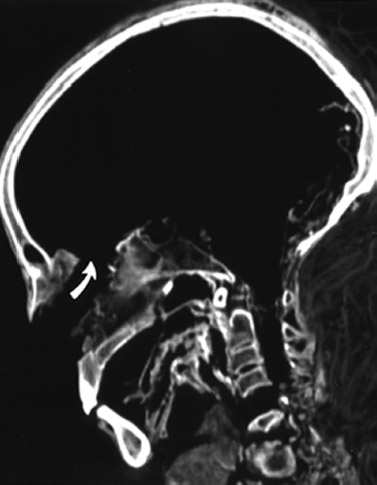
Fig. 1.1 Sagittal computed tomography (CT) scan of a mummy showing the transnasal passageway of brain removal (arrow). (From Hoffman H, Hudgins PA. Head and skull base features of nine Egyptian mum-mies: evaluation with high-resolution CT and reformation techniques. Am J Roentgenol 2002;178:1367–1376. Reprinted with permission.)
Theodor Kocher (Cushing’s mentor) modified Schloffer’s approach by submucosal removal of the septum, allowing better visualization. However, it was Oskar Hirsch, a rhinologist, who developed a completely endonasal transseptal transsphenoidal operation in 1910, based on his mentor Hajek’s treatment for sphenoid sinusitis.1,6–10 Harvey Cushing later improved the technique, using Kocher’s submucosal resection of the septum and a nasal speculum (a modified pediatric vaginal speculum).
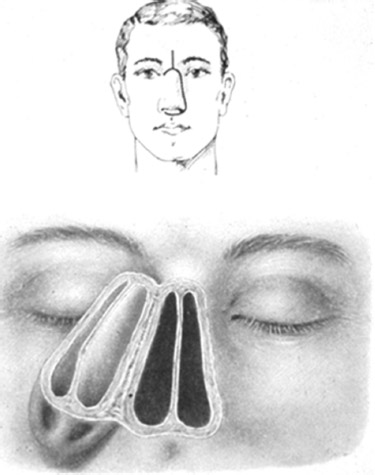
Fig. 1.2 Diagram demonstrating the lateral rhinotomy exposure of the septum and nasal turbinates of the nose just prior to exposure of the sphenoid sinus described by Schloffer.
At the same time, in the United States, Albert Halstead of Chicago modified the curvilinear incision through the nasolabial junction suggested by Allen Kanavel.11–13 His sub-labial gingival incision (Fig. 1.4) allowed more retraction of the cartilaginous septum compared with the endonasal approach, improved exposure, and provided better cosmetic results.1,6,12,14 Other attempts at the development of sellar approaches include Ottokar Chiari’s transethmoidal approach and Preysing’s transpalatal approach.6
Driven by the discouraging results of his transcranial approaches, Harvey Cushing adopted the transsphenoidal approach,13 initially using Schloffer’s procedure. He performed his first transsphenoidal operation in 1909 for a patient with acromegaly.6,15 By 1912, he had modified the procedure by combining Halstead’s sublabial incision and Kocher’s submucosal septal dissection,6,13,16 resulting in the operation still performed by most neurosurgeons today (Fig. 1.5). From 1910 to 1925, Cushing operated on 231 pituitary tumors using the sublabial transsphenoidal approach, with a mortality rate of only 5.6%.7
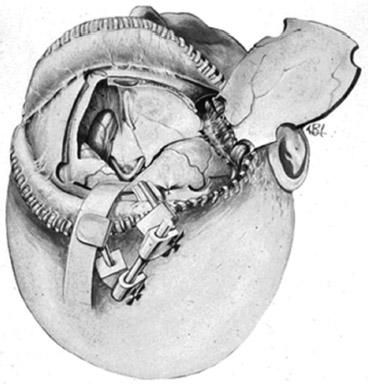
Fig. 1.3 Anatomical drawing of the subfrontal approach to the pitu-itary. This approach was popular both before and after the emergence of transsphenoidal operations.
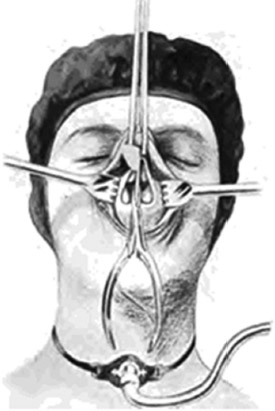
Fig. 1.4 Albert Halstead’s sublabial approach. Note the use of a trarate cheostomy for the administration of anesthetics.
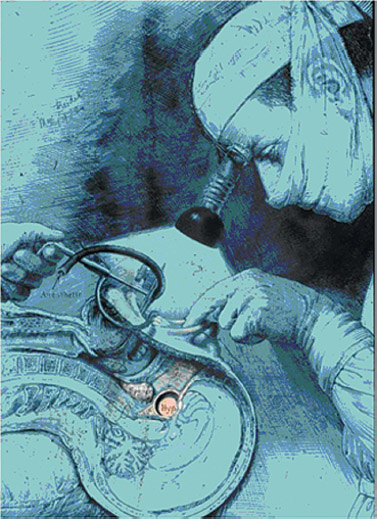
Fig. 1.5 Illustration depicting Harvey Cushing with his headlight, using a sublabial approach to the sella. Note the anesthetic tube in the special mouth gag designed by Cushing.
 Abandonment of the Transsphenoidal Approach
Abandonment of the Transsphenoidal Approach
Cushing’s intense interest in intracranial surgery led him to pursue and develop transcranial approaches to the pituitary gland. As he developed expertise and confidence in these approaches, he reduced his mortality rate with the transcranial approach to 4.6%, essentially eliminating any significant difference in surgical mortality when compared with the transsphenoidal approach.17 By the late 1920s, Cushing had treated many patients with suprasellar tumors, especially meningiomas and craniopharyngiomas, by a transfrontal approach, which enabled him to verify suprasellar tumors diagnostically and achieve a more extensive resection and decompression of the optic chiasm. The transcranial approach avoided the dreaded complications of meningitis and systemic infection, the most common causes of death associated with the transsphenoidal approach. By 1929, Cushing had virtually abandoned the transsphenoidal operation, performing pituitary surgery exclusively via the transfrontal route.17,18 As might be expected, the majority of the neurosurgical community followed Cushing’s lead.
Meanwhile, Norman Dott, who learned the transsphenoidal approach in 1923 from Cushing during a traveling fellowship at the Peter Bent Brigham Hospital in Boston, returned to Edinburgh, where he continued to advocate this procedure.19 He designed a speculum with a lighted tip, which provided superior visualization during the operation.1,7,10,18 This interim stage preserved the transsphenoidal approach from extinction.
Another key factor in the preservation of the transsphenoidal approach was the contribution of Hirsch and Hamlin. Oskar Hirsch immigrated to the United States after being expelled from Austria by the Nazis in 1938. He collaborated with Hannibal Hamlin, a neurosurgeon in the Boston community. Hirsch and Hamlin extolled the virtues of the transsphenoidal approach and reported excellent long-term results.6,8 Despite their enthusiasm, transfrontal approaches remained the most popular methods throughout the 1950s and 1960s.
 Revival of the Transsphenoidal Approach
Revival of the Transsphenoidal Approach
Numerous innovations introduced in the 1950s played an important role in the resurgence of interest in transsphenoidal surgery. With the introduction of cortisone and antibiotic therapy, total hypophysectomy could be performed with significantly reduced mortality and better long-term success.20
The two persons credited for the revival of the transsphenoidal approach are Gerard Guiot and Jules Hardy. In 1956 Guiot visited Dott, observed his meticulous technique and outstanding surgical outcomes, and returned to Paris, where he reintroduced the transsphenoidal approach.7 He further refined his technique and enhanced surgical accuracy by introducing intraoperative radiofluoroscopy to define the anatomy of the anterior skull base while maneuvering surgical instruments.17 This allowed him to apply the transsphenoidal approach to craniopharyngiomas, clivus chordomas, and parasellar lesions, and thus he played a pivotal role in the resurrection of the transsphenoidal approach during the following two decades.6,21,22
Stay updated, free articles. Join our Telegram channel

Full access? Get Clinical Tree


